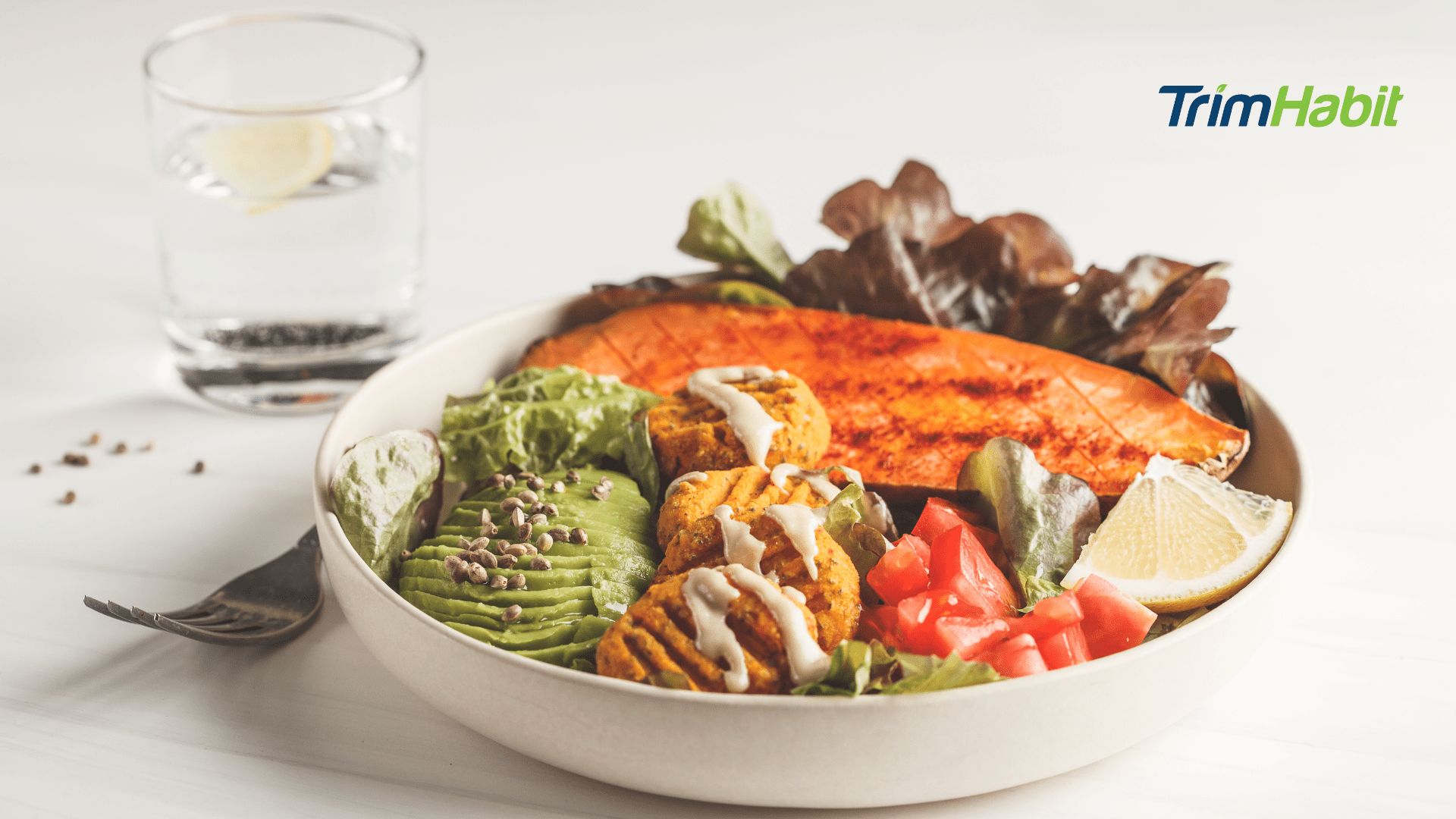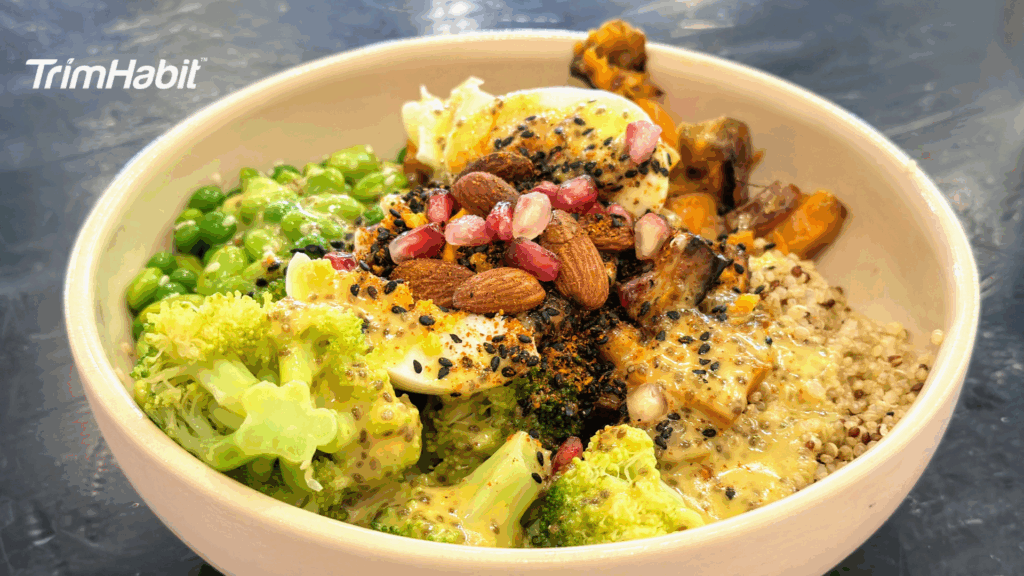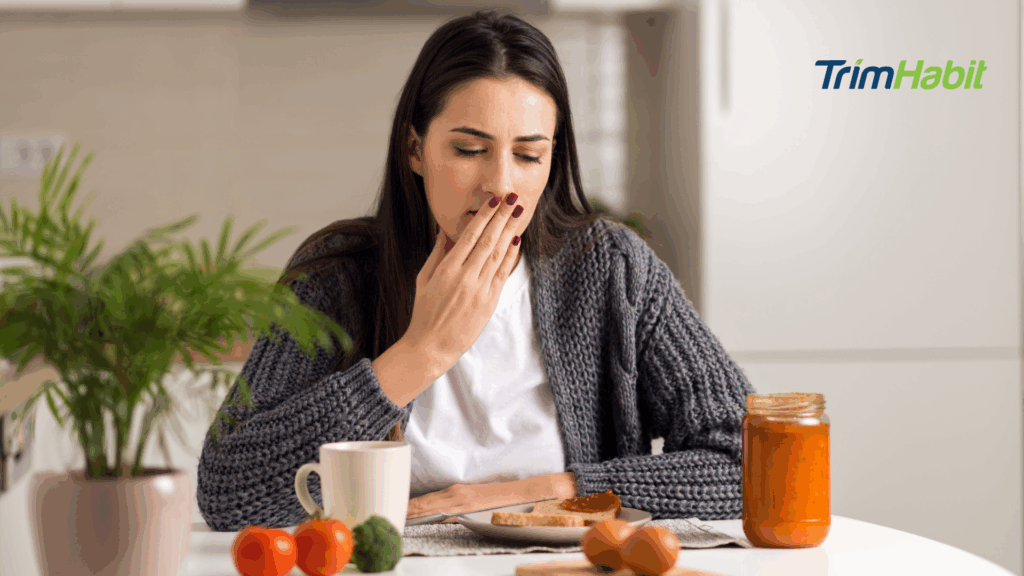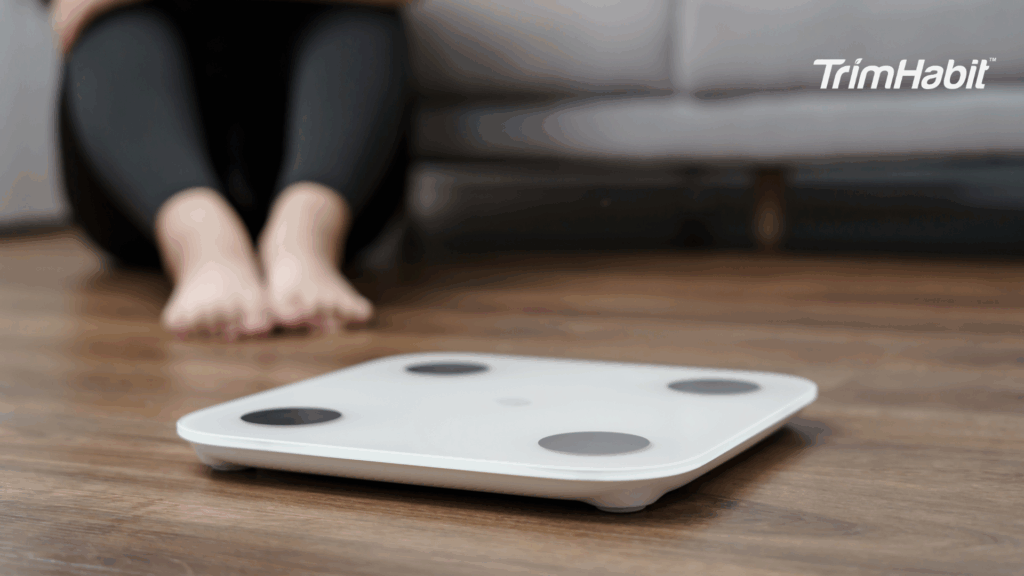Starting semaglutide as part of your health journey can be a decisive step toward managing weight and improving blood sugar levels. However, a balanced, nutritious diet greatly enhances the medication’s effectiveness. Understanding how to fuel your body with the right foods is essential for semaglutide patients to support the medication’s benefits and promote overall well-being.
In this article we’ll explore balanced diet tips for semaglutide patients, helping you make the most of your health journey with confidence and balance.
How Semaglutide Influences Appetite And Digestion
Semaglutide works as a GLP-1 receptor agonist (glucagon-like peptide-1 receptor agonist), meaning it mimics the effects of the body’s natural GLP-1 hormone. This hormone plays a key role in regulating appetite and digestion1.
Appetite Regulation
Increased Satiety (Feeling Full)
Semaglutide activates GLP-1 receptors in the hypothalamus, a brain region involved in hunger and satiety. This helps reduce the urge to eat and promotes a feeling of fullness after meals2.
Reduced Food Cravings
Semaglutide dampens the brain’s reward response to food, leading to fewer cravings, especially for high-fat or high-sugar foods. This results in a lower overall calorie intake.
Slowed Gastric Emptying
Semaglutide slows the rate at which the stomach empties food into the small intestine3. This delay:
- Prolongs the feeling of fullness after eating
- Helps stabilize blood glucose levels after meals
- May contribute to reduced meal sizes
This effect is strongest early in treatment and may become less pronounced.
Impact on Digestion
While semaglutide helps with appetite control and weight loss, it can also affect digestion through side effects such as:
- Nausea
- Vomiting
- Diarrhea
- Constipation
These dose-dependent gastrointestinal effects tend to lessen as the body adjusts to the medication.
Key Components Of A Balanced Diet For Semaglutide Users
For individuals taking semaglutide, maintaining a balanced diet with healthy foods is crucial to support weight loss, manage potential side effects, and improve overall health outcomes. The goal is to optimize nutrient intake while minimizing gastrointestinal discomfort.
Lean Protein
Why it’s important:
Protein supports muscle mass during weight loss, enhances satiety, and helps regulate blood sugar.
Sources:
- Skinless poultry
- Fish and seafood
- Eggs
- Tofu and tempeh
- Low-fat dairy (Greek yogurt, cottage cheese)
- Legumes (in moderation to avoid bloating)
Non-Starchy Vegetables
Why it’s important:
Vegetables are low in calories and high in fiber, vitamins, and minerals. They support digestion and add volume to meals without excess calories.
Examples:
- Leafy greens (spinach, kale, romaine)
- Broccoli, cauliflower
- Zucchini, cucumbers, bell peppers
- Asparagus, green beans
High-Fiber Carbohydrates
Why it’s important:
Fiber improves digestion and blood sugar control, helps you eat fewer calories, and prolongs fullness. However, fiber should be increased gradually to reduce gastrointestinal side effects4.
Sources:
- Whole grains (oats, brown rice, quinoa)
- Legumes (lentils, black beans)
- Berries, apples, pears (with skin)
- Chia seeds, flaxseeds
Healthy Fats (in Moderation)
Why it’s important:
Fats support brain and hormone health and aid in vitamin absorption. They also help meals feel more satisfying.
Sources:
- Avocados
- Nuts and seeds
- Olive oil, flaxseed oil
- Fatty fish (salmon, sardines)
Balanced Diet Tips For Semaglutide Patients
Semaglutide can significantly aid your weight loss journey and blood sugar control, but its benefits are maximized when paired with mindful eating habits. Below are practical, sustainable tips to help you feel your best while minimizing side effects.
1. Eat Slowly and Mindfully
- Take 20-30 minutes to finish meals.
- Chew thoroughly and pause between bites.
- Stop eating when you’re comfortably full, not stuffed.
Why it helps:
Slower eating enhances satiety cues and reduces nausea or bloating, which are common side effects of semaglutide.
2. Start with Small Portions
- Begin meals with smaller servings and add more only if still hungry.
- Use smaller plates to manage portions visually.
Why it helps:
Semaglutide reduces appetite, and your usual portions may be too much, increasing the risk of discomfort.
3. Limit High-Fat and Fried Foods
- Avoid greasy or fried foods, especially early in treatment.
- Choose baked, grilled, or steamed options instead.
Why it helps:
High-fat foods can slow digestion further and may trigger nausea or indigestion.
4. Avoid Drinking Large Amounts with Meals
- Sip fluids between meals instead of during them.
- Stick to small sips if drinking with food.
Why it helps:
Too much liquid with meals can cause a feeling of fullness too quickly or lead to bloating, especially if combined with refined carbohydrates.
5. Eat Consistently Throughout the Day
- Have three balanced meals or 4-5 smaller meals/snacks.
- Avoid skipping meals to prevent blood sugar dips and rebound hunger.
Why it helps:
Consistent eating supports energy, digestion, and better appetite regulation.
6. Watch for Trigger Foods
- Keep a food journal to identify items that cause nausea, bloating, or discomfort.
- Common triggers include spicy foods, caffeine, carbonated beverages, and sugar alcohols.
Why it helps:
Avoiding personal trigger foods can significantly improve your comfort and treatment adherence.
7. Stay Hydrated
- Drink water consistently throughout the day.
- Aim for at least 8 cups, more if physically active or in hot climates.
Why it helps:
Adequate fluid support for digestion helps manage common side effects like constipation.
8. Focus on Nutrient Density
- Prioritize foods that offer more nutrition per bite (lean proteins, vegetables, whole grains, healthy fats).
- Limit empty-calorie snacks or ultra-processed foods.
Why it helps:
With reduced appetite, it’s important to make every bite count nutritionally.
Managing Common Side Effects Through Diet
Semaglutide often causes gastrointestinal (GI) side effects, especially in the early stages of treatment or after dose increases. Diet plays a key role in reducing these effects.
Below are common side effects and practical dietary strategies to manage them:
Nausea
What to Do:
- Eat bland, low-fat foods: Plain toast, crackers, rice, applesauce, and bananas are gentle on the stomach.
- Avoid strong smells and spices: Heavily seasoned, greasy, or fried foods can worsen nausea.
- Try cold or room-temperature foods: Warm foods may increase nausea due to stronger aromas.
- Eat small, frequent meals: An empty stomach can trigger nausea; grazing throughout the day may help.
Foods that may help:
- Ginger tea or ginger chews
- Peppermint tea
- Dry toast or saltine crackers first thing in the morning
Vomiting
What to Do:
- Stop eating at the first sign of fullness: Overeating can trigger vomiting.
- Stay upright after meals: Avoid lying down for 30-60 minutes.
- Avoid fluid overload during meals: Drink fluids slowly and separately from meals.
When to contact a provider:
Persistent vomiting, inability to keep down fluids, or signs of dehydration should be addressed medically.
Constipation
What to Do:
- Increase fiber gradually: Add fiber-rich foods like oats, chia seeds, berries, lentils, and vegetables to avoid bloating.
- Drink plenty of water: Fiber needs fluid to move waste through the digestive tract.
- Stay active: Gentle exercise, like walking, can help stimulate bowel movements.
Foods that help relieve constipation:
- Prunes or prune juice
- Ground flaxseeds
- Whole grains
Diarrhea
What to Do:
- Temporarily follow a low-residue diet: Choose easy-to-digest, low-fiber foods like white rice, plain pasta, bananas, and applesauce.
- Avoid high-fat, spicy, or high-sugar foods: These can worsen diarrhea.
- Stay hydrated: Replenish fluids and electrolytes with water, broth, or electrolyte drinks.
Bloating or Gas
What to Do:
- Limit carbonated drinks and gas-producing foods: Beans, cabbage, onions, and sugar alcohols (found in diet foods) can cause gas.
- Eat slowly and avoid swallowing air: Chew thoroughly, avoid chewing gum or drinking through straws.
Sample Meal Ideas And Snack Options
These meals are designed to support semaglutide treatment by being balanced, gentle on the digestive system, and portion-conscious. Each option emphasizes lean protein, fiber, healthy fats, and hydration, while minimizing foods that typically worsen side effects like nausea or bloating.
Breakfast Ideas
1. Greek Yogurt Bowl
- Plain Greek yogurt (low-fat or full-fat, depending on tolerance)
- Fresh berries (e.g., blueberries or raspberries)
- 1 tbsp chia seeds or ground flaxseed
- Small drizzle of honey or cinnamon
2. Oatmeal with Almond Butter
- Rolled oats cooked with water or unsweetened almond milk
- Sliced banana or apple
- 1 tsp almond butter
- Sprinkle of cinnamon
3. Scrambled Eggs with Spinach
- 2 eggs scrambled with fresh spinach
- Side of whole grain or sourdough toast
- Optional: sliced avocado
Lunch Ideas
1. Grilled Chicken Salad
- Mixed greens (spinach, arugula, romaine)
- Grilled chicken breast
- Cherry tomatoes, cucumber, shredded carrots
- Olive oil and lemon or balsamic vinegar dressing
2. Quinoa Bowl
- Cooked quinoa
- Roasted vegetables (zucchini, bell peppers, broccoli)
- Chickpeas or tofu
- Tahini-lemon dressing
3. Turkey and Avocado Wrap
- Whole wheat or low-carb wrap
- Sliced turkey breast
- Avocado, lettuce, tomato
- Side of carrot sticks or a small apple
Dinner Ideas
1. Baked Salmon with Vegetables
- 3-4 oz salmon fillet, baked with lemon and herbs
- Steamed broccoli or green beans
- Small sweet potato or brown rice
2. Stir-Fry with Lean Protein
- Chicken, shrimp, or tofu stir-fried with bok choy, mushrooms, and snap peas
- Garlic and low-sodium soy sauce or coconut aminos
- Served over a small portion of jasmine or cauliflower rice
3. Lentil Soup with Whole Grain Toast
- Homemade or low-sodium lentil soup with carrots and celery
- Whole grain toast or rye bread
- Side of sliced cucumber or a few olives
Snack Options
Light, high-protein, or fiber-rich snacks to maintain energy and satiety:
- Hard-boiled egg
- Apple slices with almond or peanut butter
- Cottage cheese with pineapple or cucumber
- Small handful of mixed nuts (unsalted)
- Roasted chickpeas or edamame
- Rice cakes with hummus
- Baby carrots or bell pepper slices with guacamole
- Unsweetened protein shake or smoothie with spinach and berries
Tips for Meals & Snacks
- Keep portions modest, especially early in treatment.
- Choose whole foods over processed ones to reduce GI irritation.
- Include protein in each meal/snack to help maintain muscle mass and satiety.
- Avoid skipping meals—this can worsen side effects and blood sugar fluctuations.
Lifestyle Tips Beyond Diet
While a healthy diet is a central part of success on semaglutide, sustainable results come from a broader lifestyle approach. These strategies can help you manage side effects, enhance weight loss, and maintain long-term health.
Physical Activity
Why it matters:
Regular movement helps improve insulin sensitivity, supports weight loss, and enhances mood and energy levels.
Tips:
- Aim for at least 150 minutes of moderate activity per week (e.g., brisk walking, cycling, swimming).
- Include strength training 2-3 times per week to preserve muscle mass during weight loss.
- Start slowly if you’re new to exercise, and build up as tolerated.
Sleep Quality
Why it matters:
Poor sleep can increase hunger hormones (like ghrelin), reduce insulin sensitivity, and undermine weight loss.
Tips:
- Aim for 7-9 hours of sleep per night.
- Maintain a consistent sleep schedule, even on weekends.
- Limit screen time 1 hour before bed and create a calming bedtime routine.
Stress Management
Why it matters:
Chronic stress elevates cortisol, increasing cravings, promoting fat storage, and disrupting digestion.
Tips:
- Try mindfulness techniques like deep breathing, meditation, or yoga.
- Engage in regular hobbies or relaxing activities.
- Limit exposure to high-stress environments when possible.
Routine and Structure
Why it matters:
Semaglutide can dull hunger cues, making skipping meals or eating inconsistently easy, which is crucial for controlling blood sugar levels.
Tips:
- Establish a regular eating schedule to ensure you’re nourishing your body.
- Plan meals and snacks to prevent impulsive eating.
- Set reminders for meals, medications, and hydration if needed.
Monitor Progress—But Not Just the Scale
Why it matters:
Weight loss may not always be linear. Tracking other measures of progress helps maintain motivation.
Track:
- Energy levels
- Mood and mental clarity
- Clothing fit or body measurements
- Blood sugar or blood pressure (if relevant)
- Strength and endurance improvements
Stay Connected
Why it matters:
Social support improves accountability and emotional well-being during lifestyle changes.
Tips:
- Consider a support group, online forum, or accountability buddy.
- Share your goals with trusted friends or family.
- Work with a healthcare provider or registered dietitian for personalized support.









